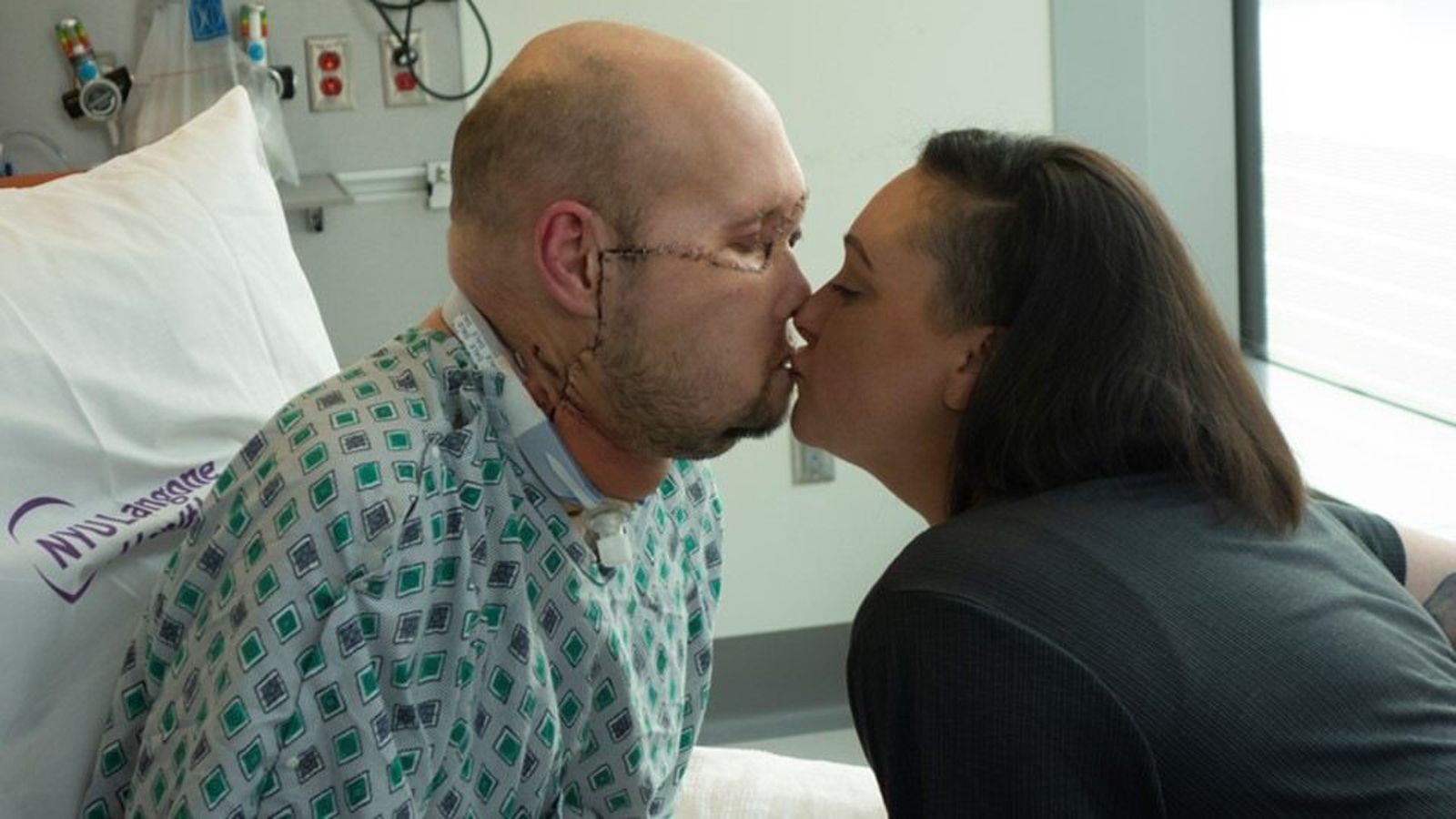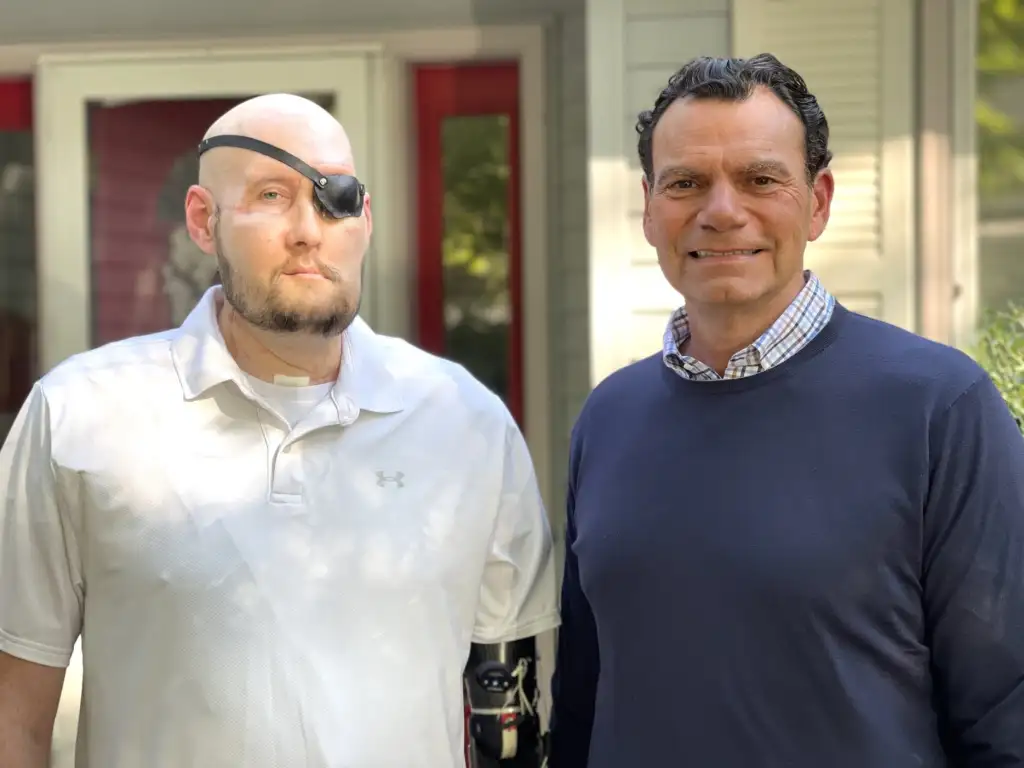It was an unexpected moment for Meagan James.
At NYU Langone Health in New York, a team of surgeons achieved a groundbreaking medical feat: the world’s first successful whole-eye transplant in a living person, performed on her husband, Aaron James.
After a work accident left Aaron without his left eye and part of his face, he was given not only a new eye but also underwent a partial face transplant.
When Meagan saw her husband’s new eye for the first time, she noticed the post-surgery swelling and observed that the eye was brown, whereas Aaron’s natural eyes were ocean-blue.
She also saw his new nose, lips, and cheek, where some beard stubble had already grown. She saw a face filled with gratitude, and that’s when the emotions overwhelmed her.
For Meagan, who had been married to Aaron for 20 years, the experience was a mix of astonishment and joy.
“It was a crazy, great, weird, strange, ecstatic, happy feeling,” Meagan recalled. “I was just happy he made it through, and everything was good in the moment.”
On a late May day, over 140 surgeons at NYU Langone Health completed Aaron’s complex transplantation procedure, lasting about 21 hours.
The surgery involved transplanting an entire left eye and parts of the face from a single donor, marking a significant medical milestone.
Aaron’s newly transplanted eye is showing promising signs of health, although he currently cannot see through it.
He remains hopeful that vision may eventually return and that his pioneering procedure will advance the field of transplant medicine.
“That’s really my biggest hope,” Aaron expressed. “If I can see out of it, that’s great. But if it’ll kick-start the next path in the medical field, then I’m all for it.”
Seeing Aaron with his new eye and face wasn’t as shocking for Meagan as seeing him on the night of his accident, she recounted.
Aaron, a 46-year-old military veteran from Arkansas, worked as a high-voltage power lineman.
The incident occurred in June 2021 while he was working in Mississippi, where a sudden contact with a live wire resulted in a fatal 7,200-volt electric shock.
The accident caused extensive injuries to Aaron’s face, including the loss of his left eye, nose, lips, left cheek area, and left arm.
Back home in Arkansas, Meagan and their high school-aged daughter, Allie, were driving back from the grocery store when Meagan received a call from an unfamiliar number.
Despite not recognizing the caller, she answered and heard the words “Aaron,” “accident,” and “serious.”
Immediately, Meagan packed essentials and embarked on a four-and-a-half-hour drive to Mississippi, where Aaron was being treated at a local hospital.
During the journey, she received another call—this time from a doctor—who described Aaron’s critical condition and explained that he had suffered an electrocution.
“Is he OK? Is he going to be OK?” Meagan asked anxiously. The doctor’s response was solemn: “The only thing that I can promise you is that he won’t die before you get here.”
Meagan remembered how every morning before Aaron left for work, she would remind him to “be careful.” She often thinks back to that morning and wonders if she had said those words on the day of the accident.
Meagan remained by Aaron’s side as he was transferred between medical facilities for intensive care, reconstructive surgeries, and eventually the amputation of his left arm.
After being airlifted to a burn unit in Dallas, Allie, who was staying with her grandmother at the time, was allowed to visit her father.
“When I saw him, his chinbone was exposed,” Allie recounted. “I could see his eye socket and everything. I was seeing his skull, and I think that’s the part that was kind of freaky for me.
I was like ‘Oh, my goodness, his face is gone.’ Most of my worries were just how he was going to be when he was awake and aware.”
Aaron has no memory of the accident. “Basically, I got up, went to work, and woke up six weeks later in Dallas, Texas,” he recalled. “It’s a weird feeling when you just all of a sudden wake up in a hospital.”
The first time Aaron saw his post-accident reflection was from his hospital bed in Dallas. He asked Meagan to take a photo, although she hesitated initially.
“She said, ‘Are you sure?’ I said, ‘Yeah, it’ll be fine,’” Aaron remembered.
“She took a picture, and she spun the phone around, and I was just like, ‘Oh, my goodness, this is a bad deal right here,’” he recounted.
“I mean, I felt OK, so I knew I was going to be OK. We were just going to have a long road ahead of us.”

Aaron’s medical team had mentioned the possibility of a face transplant to Meagan. When she broached the subject with Aaron, he readily agreed.
“As soon as the face transplant got talked about, that’s when I thought, ‘Man, this is a big deal,’ because they just don’t do those every day,” Aaron said.
In New York, Dr. Eduardo Rodriguez, director of the Face Transplant Program at NYU Langone Health and experienced in such complex surgeries, was introduced to Aaron’s case by specialists in Texas.
After reviewing the details of Aaron’s accident and the resulting injuries, Rodriguez marveled at Aaron’s survival.
“To see him walking when he was completely down for the count in the hospital—multiorgan system failure, breathing tube, is he going to make it, is he going to have neurological injury—to see him without any of those sequelae, it’s very impressive,” Rodriguez remarked.
“It’s a testament to modern medicine,” he added. “It’s a testament to this patient and his family. And it’s also a testament that, in these cases, there’s some celestial involvement where it wasn’t his time to go.”
Discussions about a potential transplant continued even after Aaron’s medical team in Texas removed his left eye due to severe pain.
At Rodriguez’s request, the Texas team preserved as much of the optic nerve as possible, offering a chance for a future eye transplant.
Rodriguez discussed with Aaron the possibility of not only a partial face transplant but also an unprecedented whole-eye transplant.
He cautioned Aaron that the donor eye might not restore vision immediately, as communication between the transplanted eye and the brain was uncertain.
“But I said, ‘Even if it doesn’t work, I’ll have an eye, and it will be at least normal-looking, and then you all could learn something off of this,’” Aaron recalled. “You have to have a patient zero.”
Aaron was listed as a potential transplant candidate in February 2023. Within a few months, in May, the opportunity for the whole-eye and partial face transplant arose.
The procedure was considered risky for Rodriguez and his team, as no medical team had successfully performed a human eye transplant in a living patient before.
“It’s completely uncharted territory,” Rodriguez acknowledged.
### The groundbreaking surgery
The intricate surgery unfolded in two operating rooms. In one room, surgeons prepared Aaron by removing the damaged parts of his face that would be replaced with donor tissue.
Meanwhile, Rodriguez and his team meticulously dissected the donor face and eyeball in the other room.
“That part of the operation took about 12 hours,” Rodriguez recalled. “Now I have to ensure that Aaron’s room is ready to receive the face. We cut the blood vessels, we disconnect it from the donor, and the race begins. At this point, the face and the eye are not receiving any blood supply.”
The next critical step involved connecting the donor face and eyeball to Aaron. For the eye transplant, the team injected adult stem cells derived from the donor’s bone marrow into the optic nerve during the transplant.
These stem cells, particularly the CD34 stem cells, were aimed not only at immune modulation but also at potentially aiding nerve regeneration.
“We were able to define a specific cell, a CD34, which is an adult stem cell that has some potential benefits—not only in immune modulation, because it is a transplant, but also in neuroregeneration,” Rodriguez explained.
“At the connection of the optic nerve from the donor to the recipient, right at that site, we injected those CD34 stem cells.”
Dr. José-Alain Sahel, clinical spokesperson for the American Academy of Ophthalmology, emphasized the importance of reconnecting Aaron’s optic nerve to the donor eye during the surgery.
Although not directly involved in the procedure, Sahel, who chairs the Department of Ophthalmology at the University of Pittsburgh School of Medicine and conducts related experimental research, commended the NYU Langone Health team’s approach.
“It was very smart that they didn’t cut the optic nerve too far from the eyeball when the eye was removed in the recipient,” Sahel noted.
“I think what remains to be done—which is a major, major undertaking—will be how to regrow the optic nerve, guide its fibers or axons to the appropriate targets, as well as ensuring that the corneal nerves are well-preserved.
What we learn from this is that potentially the surgery can work, and then we should promote more research, more investment into research on corneal and optic nerve regeneration.”
